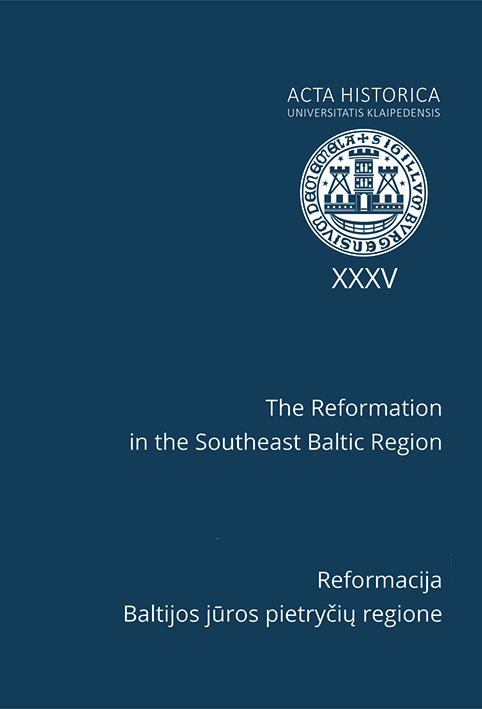Volume 35 (2017): The Reformation in the Southeast Baltic Region = Reformacija Baltijos jūros pietryčių regione, December 2017

Order by:
Pub. online: 15 Dec 2017
Type: Editorial Note
 Open Access
Open Access
Journal:
Acta Historica Universitatis Klaipedensis
Volume 35 (2017): The Reformation in the Southeast Baltic Region = Reformacija Baltijos jūros pietryčių regione, pp. 5–6
Pub. online: 15 Dec 2017
Type: Introduction
 Open Access
Open Access
Journal:
Acta Historica Universitatis Klaipedensis
Volume 35 (2017): The Reformation in the Southeast Baltic Region = Reformacija Baltijos jūros pietryčių regione, pp. 7–12
Pub. online: 15 Dec 2017
Type: Introduction
 Open Access
Open Access
Journal:
Acta Historica Universitatis Klaipedensis
Volume 35 (2017): The Reformation in the Southeast Baltic Region = Reformacija Baltijos jūros pietryčių regione, pp. 13–17
Pub. online: 15 Dec 2017
Type: Article
 Open Access
Open Access
Journal:
Acta Historica Universitatis Klaipedensis
Volume 35 (2017): The Reformation in the Southeast Baltic Region = Reformacija Baltijos jūros pietryčių regione, pp. 21–44
Abstract
Pub. online: 15 Dec 2017
Type: Article
 Open Access
Open Access
Journal:
Acta Historica Universitatis Klaipedensis
Volume 35 (2017): The Reformation in the Southeast Baltic Region = Reformacija Baltijos jūros pietryčių regione, pp. 45–82
Abstract
Pub. online: 15 Dec 2017
Type: Article
 Open Access
Open Access
Journal:
Acta Historica Universitatis Klaipedensis
Volume 35 (2017): The Reformation in the Southeast Baltic Region = Reformacija Baltijos jūros pietryčių regione, pp. 85–101
Abstract
Pub. online: 15 Dec 2017
Type: Article
 Open Access
Open Access
Journal:
Acta Historica Universitatis Klaipedensis
Volume 35 (2017): The Reformation in the Southeast Baltic Region = Reformacija Baltijos jūros pietryčių regione, pp. 103–134
Abstract
Pub. online: 15 Dec 2017
Type: Article
 Open Access
Open Access
Journal:
Acta Historica Universitatis Klaipedensis
Volume 35 (2017): The Reformation in the Southeast Baltic Region = Reformacija Baltijos jūros pietryčių regione, pp. 135–159
Abstract
Pub. online: 15 Dec 2017
Type: Article
 Open Access
Open Access
Journal:
Acta Historica Universitatis Klaipedensis
Volume 35 (2017): The Reformation in the Southeast Baltic Region = Reformacija Baltijos jūros pietryčių regione, pp. 163–188
Abstract
Pub. online: 15 Dec 2017
Type: Article
 Open Access
Open Access
Journal:
Acta Historica Universitatis Klaipedensis
Volume 35 (2017): The Reformation in the Southeast Baltic Region = Reformacija Baltijos jūros pietryčių regione, pp. 189–208
Abstract